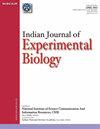Hematopoietic and Hepatoprotective Activity of Basella alba Fruit Extract in Experimental Animal Model
IF 0.7
4区 生物学
Q4 BIOLOGY
引用次数: 0
Abstract
Basella alba fruit extract (BAFE) has been used in rural eastern India by the traditional practitioners to treat anemia during pregnancy. In the present study, hematopoietic and hepatoprotective activity of BAFE was established in animal model. Animal ethical permission was obtained before experiments. Male Swiss albino rats were divided into: gr.1- sham control, gr.2- disease control (anemia or hepatotoxicity), gr.3- standard drug treated, gr.4- BAFE treated (low dose) and gr.5- BAFE treated (high dose). Anemia was induced in animals through blood loss at regular intervals and hematological, cytokine, antioxidant parameters and RBC morphology were done. Hepatotoxicity was induced in animals by CCl4 (1 mL/kg/p.o.) and serum biochemistry, cytokine, antioxidant parameters and histology were done. There was a significant improvement of hematology (Hb, TC of RBC, TC of WBC, hematocrit, serum iron, TIBC), cytokine (IL 1β), antioxidant (SOD, catalase, LPO, GSH) and RBC morphology in BAFE treated animals when compared to group 2 animals. Significant improvement in biochemical (AST, ALT, γGT, ACP, ALP, total bilirubin), cytokine (IL 1β, IL 4, IL 12, IL 17, cathepsin K, TNF α), antioxidant (SOD, catalase, LPO, GSH) and liver histology were observed in BAFE treated animals when compared to group 2 animals. The present study confirmed the hematopoietic and hepatoprotective activity of BAFE in animal model and warrants further studies.白底菇果实提取物在实验动物模型中的造血和保肝活性
白Basella果实提取物(BAFE)在印度东部农村地区被传统从业者用于治疗怀孕期间的贫血。本研究在动物模型上建立了BAFE的造血和保肝活性。实验前获得动物伦理许可。将雄性瑞士白化病大鼠分为:gr.1-假对照组,gr.2-疾病对照组(贫血或肝毒性),gr.3-标准药物治疗,gr.4- BAFE治疗(低剂量)和gr.5- BAFE治疗(高剂量)。通过定期失血诱导动物贫血,测定血液学、细胞因子、抗氧化指标和红细胞形态。以CCl4 (1 mL/kg/p.o)致小鼠肝毒性,进行血清生化、细胞因子、抗氧化指标及组织学检查。与2组动物相比,BAFE处理动物的血液学(Hb、红细胞TC、白细胞TC、红细胞压积、血清铁、TIBC)、细胞因子(IL - 1β)、抗氧化剂(SOD、过氧化氢酶、LPO、GSH)和红细胞形态均有显著改善。与2组相比,BAFE处理动物的生化指标(AST、ALT、γ - gt、ACP、ALP、总胆红素)、细胞因子(IL 1β、IL 4、IL 12、IL 17、组织蛋白酶K、TNF α)、抗氧化指标(SOD、过氧化氢酶、LPO、GSH)和肝脏组织学指标均有显著改善。本研究在动物模型上证实了BAFE的造血和保肝活性,值得进一步研究。
本文章由计算机程序翻译,如有差异,请以英文原文为准。
求助全文
约1分钟内获得全文
求助全文
来源期刊
CiteScore
1.57
自引率
33.30%
发文量
84
审稿时长
6 months
期刊介绍:
This journal, started in 1963, publishes full papers, notes and reviews in cell biology, molecular biology, genetic engineering, endocrinology, reproductive biology, immunology, developmental biology, comparative physiology, radiation biology, chronobiology, microbiology, pharmacology, toxicology and other biological fields including instrumentation and methodology. The papers having experimental design involving alteration and/or manipulation in biological system(s) providing insight into their functioning are considered for publication. Studies involving higher animals, human beings and of clinical nature are not encouraged for publication in the journal.

 求助内容:
求助内容: 应助结果提醒方式:
应助结果提醒方式:


